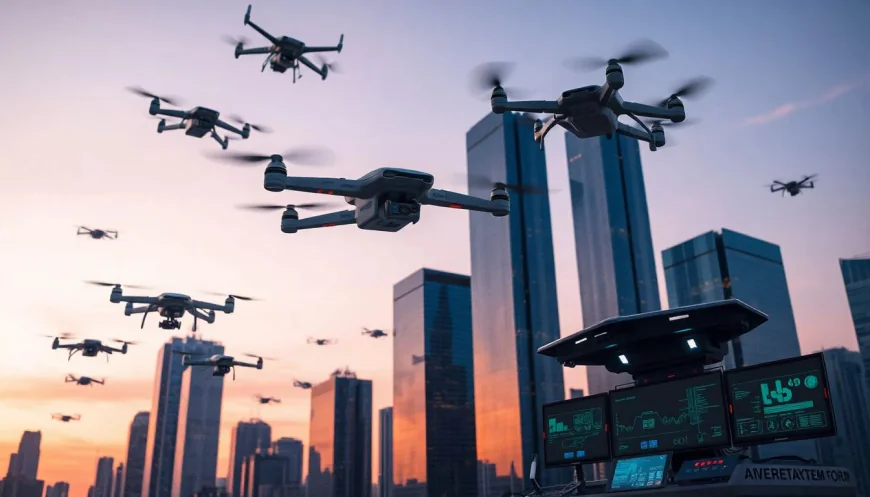Comprehensive Guide to Drones: Exploring the Future of Aerial Technology
Drones are no longer just toys—they are becoming vital tools in many industries. As technology advances, drones are becoming smaller, smarter, and more useful. From taking stunning photos to inspecting tall bridges, drones are shaping tomorrow’s world. Understanding how they work and where they are headed can help you make better decisions about using them.

What Are Drones? An Overview of Unmanned Aerial Vehicles (UAVs)
Definition and Basic Concepts
Drones, or UAVs, are flying machines that operate without a pilot onboard. They are controlled remotely or through pre-programmed routes. Think of them as robotic birds, designed for specific tasks. There are many types of drones, ranging from tiny handheld units to large unmanned aircraft.
Historical Development
The history of drones dates back to World War II, but recent advances have made them widely available. In the 2000s, small consumer models hit the market, sparking a surge of interest. Key milestones include GPS integration in the early 2010s and the rise of drone delivery pilots. Companies and governments doubled down on drone technology after seeing its potential.
Types of Drones
- Consumer Drones: Perfect for hobbyists and photographers.
- Commercial Drones: Used for business tasks like mapping and crop monitoring.
- Military Drones: Operated for defense and surveillance.
- Hobbyist vs. Professional-Grade Drones: Hobby models are simple and affordable, while professional drones offer high-end features for serious work.
How Drones Work: Technology and Components
Core Components
Drones have several key parts:
- Flight controllers: The brain of the drone, keeping it stable.
- Propulsion systems: Motors and propellers that generate movement.
- Sensors and cameras: For navigation and capturing images.
- GPS modules: Help with precise positioning and flight routes.
Flight Mechanics and Control Systems
Drones fly using principles like lift, thrust, and balance. They can be controlled with a remote or fly automatically. Many use software with artificial intelligence to avoid obstacles and follow routes. This tech makes flying drones easier and safer.
Advances in Drone Technology
New tech keeps pushing drones further:
- Better batteries for longer flights.
- Obstacle avoidance keeps drones safe around objects.
- Real-time data streams enable instant video and data transfer.
Applications of Drones Across Industries
Aerial Photography and Videography
Drones have changed how we shoot photos and videos. Filmmakers, real estate agents, and event organizers love them for capturing breathtaking views. National Geographic uses drones for remote exploration, showing their potential in media.
Agriculture and Precision Farming
Farmers use drones to monitor fields and check crop health. Multispectral sensors help spot problems early, saving time and money. This tech can tell us which plants need water or treatment.
Infrastructure Inspection and Maintenance
Inspecting power lines, wind turbines, bridges, and buildings becomes safer with drones. They can reach tough spots and save workers from dangerous climbs and risks.
Delivery and Logistics
Big firms like Amazon are testing drone delivery to speed up shipping. Drones can cut delivery times, especially in hard-to-reach places. But hurdles like regulations and safety still remain.
Emergency Response and Disaster Management
During disasters, drones can help find people trapped or injured. They also deliver supplies to areas impossible for vehicles to reach quickly. This can save lives in critical moments.
Regulations and Safety Considerations
Legal Frameworks and Guidelines
Rules vary by country. In the US, the FAA oversees drone use, requiring registration for most flying devices. Pilots must follow standard guidelines and sometimes obtain licenses. Globally, standards are being developed to ensure safety.
Privacy and Ethical Concerns
Drones can easily capture private moments or surveillance footage. This raises privacy issues. It’s vital to balance innovation with respecting personal rights. Companies need clear policies on data collection.
Safety Tips and Best Practices
- Always keep your drone within sight.
- Check weather conditions before flying.
- Maintain safe distances from people and property.
- Follow pre-flight checklists.
- Know how to handle malfunctions, like losing connection.
Future Trends and Innovations in Drone Technology
Emerging Technologies
Expect more drone swarms—groups flying together in coordination. AI will get smarter, letting drones do more complex tasks automatically. These advances may lead to new uses in delivery, surveillance, and entertainment.
Market Growth and Industry Predictions
By 2030, the drone industry is forecasted to grow rapidly, possibly reaching over $50 billion globally. Sectors like agriculture, construction, and emergency services will benefit most from this growth.
Challenges and Opportunities
Regulatory hurdles remain a barrier, especially for commercial use. But there are also many opportunities for startups and entrepreneurs to develop innovative solutions. Sustainability efforts aim to make drones more eco-friendly.
Conclusion
Drones have already changed many industries and will continue to do so. Technical advances, smarter features, and new regulations will shape their future. Whether you’re a hobbyist or a business owner, understanding drones helps you make smarter choices. As their benefits expand, responsible use will be key to unlocking their full potential.
Take note: embracing drone technology today can give you an edge tomorrow. Stay informed, fly safely, and explore the many possibilities drones offer.



 VARSHITHA
VARSHITHA